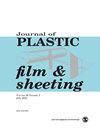Coating of a viscoplastic material onto a moving porous web during forward roll coating process: A theoretical study
IF 1.5
4区 材料科学
Q3 MATERIALS SCIENCE, COATINGS & FILMS
引用次数: 1
Abstract
In this paper, a mathematical model of forward roll for coating a thin viscoplastic fluid onto a moving porous web is developed when the web passes through a small gap between the two rigid rolls. The conservation equations in the light of lubrication approximation theory are non-dimensionalized and solutions for the velocity profile, flow rate, pressure distribution are calculated numerically by using Range-Kutta-Fehlberg’s method. It is found that by changing (increasing/decreasing) the material parameters, one can really control the engineering quantities like velocity distribution, flow rate, pressure distribution, and penetration depth The velocity graphs show that the gap between the velocity curves decrease, as fluid moves toward the separation point. This has a significant effect on the final volume of fluid flowing as at the separation point the fluid splits evenly. It was also found that the degree of fluid penetration is affected by the web flexibility and permeability. It has also been found that viscoelastic parameter and ratio of viscous to elastic forces have great impact on the emerging parameters, furthermore, the pressure gradient has been significantly affected with the variation in permeability and deformability. It is worth mentioning that the present study is a quick reference for the engineer working in coating industries and to compare the results with experimental data. Some results are shown graphically.前滚涂覆过程中粘塑性材料在移动多孔腹板上的涂覆:理论研究
本文建立了当移动的多孔腹板通过两个刚性辊之间的小间隙时,将薄粘塑性流体涂覆在多孔腹板上的前辊的数学模型。根据润滑近似理论对守恒方程进行无量纲化处理,采用Range-Kutta-Fehlberg方法对速度剖面、流量、压力分布进行数值计算。通过改变(增加/减少)材料参数,可以真正控制速度分布、流量、压力分布和侵彻深度等工程量。速度图显示,随着流体向分离点移动,速度曲线之间的间隙减小。这对流体流动的最终体积有显著的影响,因为在分离点流体均匀地分裂。研究还发现,流体的渗透程度受腹板柔韧性和渗透率的影响。黏弹性参数和粘弹性比对新兴参数有较大影响,渗透率和变形能力的变化对压力梯度有显著影响。值得一提的是,本研究为涂料行业的工程师提供了快速参考,并可将结果与实验数据进行比较。一些结果用图形显示。
本文章由计算机程序翻译,如有差异,请以英文原文为准。
求助全文
约1分钟内获得全文
求助全文
来源期刊

Journal of Plastic Film & Sheeting
工程技术-材料科学:膜
CiteScore
6.00
自引率
16.10%
发文量
33
审稿时长
>12 weeks
期刊介绍:
The Journal of Plastic Film and Sheeting improves communication concerning plastic film and sheeting with major emphasis on the propogation of knowledge which will serve to advance the science and technology of these products and thus better serve industry and the ultimate consumer. The journal reports on the wide variety of advances that are rapidly taking place in the technology of plastic film and sheeting. This journal is a member of the Committee on Publication Ethics (COPE).
 求助内容:
求助内容: 应助结果提醒方式:
应助结果提醒方式:


